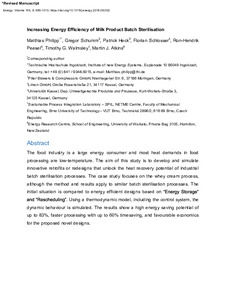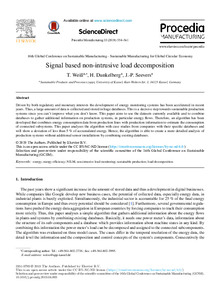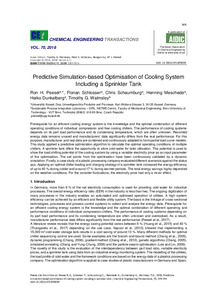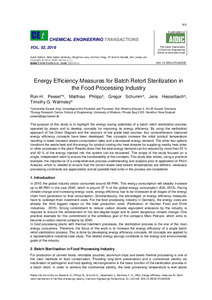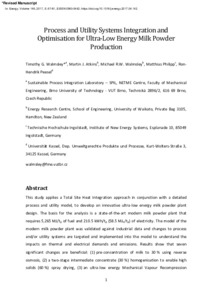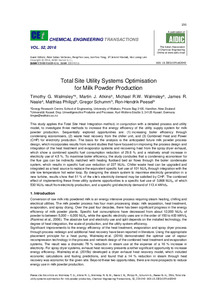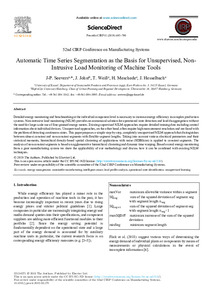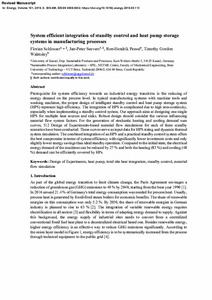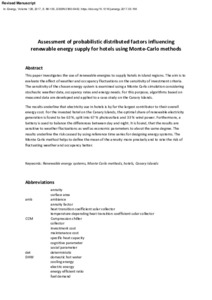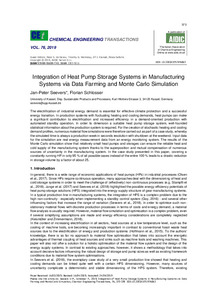Suche
Anzeige der Dokumente 1-10 von 17
Aufsatz

 Increasing energy efficiency of milk product batch sterilisation
Increasing energy efficiency of milk product batch sterilisation
(2018-09-07)
The food industry is a large energy consumer and most heat demands in food processing are low-temperature. The aim of this study is to develop and simulate innovative retrofits or redesigns that unlock the heat recovery potential of industrial batch sterilisation processes. The case study focuses on the whey cream process, although the method and results apply to similar batch sterilisation processes. The initial situation is compared to energy efficient designs based on “Energy Storage” and “Rescheduling”. Using a ...
Aufsatz

 Signal based non-intrusive load decomposition
Signal based non-intrusive load decomposition
(2019-05-29)
Driven by both regulatory and monetary interests the development of energy monitoring systems has been accelerated in recent years. Thus, a large amount of data is collected and stored in huge databases. This is a decisive step towards sustainable production systems since you can’t improve what you don’t know. This paper aims to use the datasets currently available and to combine databases to gather additional information on production systems, in particular energy flows. Therefore, an algorithm has been developed ...
Aufsatz
 Predictive Simulation-based Optimisation of Cooling System Including a Sprinkler Tank
Predictive Simulation-based Optimisation of Cooling System Including a Sprinkler Tank
(2018)
Prerequisite for an efficient cooling energy system is the knowledge and the optimal combination of different operating conditions of individual compression and free cooling chillers. The performance of cooling systems depends on its part load performance and its condensing temperature, which are often unknown. Recorded energy data remains unused and manufacturers' data significantly differs from the real performance. For this purpose, manufacturer and real data are combined and continuously adapted to form partial ...
Aufsatz
 Energy Efficiency Measures for Batch Retort Sterilization in the Food Processing Industry
Energy Efficiency Measures for Batch Retort Sterilization in the Food Processing Industry
(2016)
The purpose of this study is to highlight the energy saving potentials of a batch retort sterilization process operated by steam and to develop concepts for improving its energy efficiency. By using the methodical approach of the Onion Diagram and the recovery of low grade heat sources, four comprehensive improved energy efficiency concepts have been developed. Two concepts increase the initial product temperature resulting in lower transient steam consumption rates and a decreased energy demand. The other two options ...
Aufsatz

 Process and utility systems integration and optimisation for ultra-low energy milk powder production
Process and utility systems integration and optimisation for ultra-low energy milk powder production
(2017-04-26)
This study applies a Total Site Heat Integration approach in conjunction with a detailed process and utility model, to develop an innovative ultra-low energy milk powder plant design. The basis for the analysis is a state-of-the-art modern milk powder plant that requires 5265 MJ/tp of fuel and 210.5 kWh/tp (58.5 MJe/tp) of electricity. The model of the modern milk powder plant was validated against industrial data and changes to process and/or utility systems are targeted and implemented into the model to understand ...
Aufsatz
 Total Site Utility Systems Optimisation for Milk Powder Production
Total Site Utility Systems Optimisation for Milk Powder Production
(2016)
This study applies the Total Site Heat Integration method, in conjunction with a detailed process and utility model, to investigate three methods to increase the energy efficiency of the utility supply system for milk powder production. Sequentially explored opportunities are: (1) increasing boiler efficiency through condensing economisers, (2) waste heat recovery from the chiller unit, and (3) Combined Heat and Power (CHP) for electricity production. The basis for the analysis is the anticipated future milk powder ...
Aufsatz

 Automatic Time Series Segmentation as the Basis for Unsupervised, Non-Intrusive Load Monitoring of Machine Tools
Automatic Time Series Segmentation as the Basis for Unsupervised, Non-Intrusive Load Monitoring of Machine Tools
(2019)
Detailed energy monitoring and benchmarking at the individual component level is necessary to increase energy efficiency in complex production systems. Non-intrusive load monitoring (NILM) provides an economical solution for operational state detection and load disaggregation without the need for large-scale use of fine-grained energy meters. Existing supervised NILM approaches require detailed training data including control information about individual devices. Unsupervised approaches, on the other hand, often ...
Aufsatz

 System efficient integration of standby control and heat pump storage systems in manufacturing processes
System efficient integration of standby control and heat pump storage systems in manufacturing processes
(2019-05-24)
Prerequisite for system efficiency towards an industrial energy transition is the reducing of energy demand on the process level. In typical manufacturing systems with machine tools and washing machines, the proper design of intelligent standby control and heat pump storage system (HPS) represent high efficiency. The integration of HPS is complicated due to high non-continuity, especially when implementing a standby control system. Our approach aims at designing one single HPS for multiple heat sources and sinks. ...
Aufsatz

 Assessment of probabilistic distributed factors influencing renewable energy supply for hotels using Monte-Carlo methods
Assessment of probabilistic distributed factors influencing renewable energy supply for hotels using Monte-Carlo methods
(2017-04-05)
This paper investigates the use of renewable energies to supply hotels in island regions. The aim is to evaluate the effect of weather and occupancy fluctuations on the sensitivity of investment criteria. The sensitivity of the chosen energy system is examined using a Monte Carlo simulation considering stochastic weather data, occupancy rates and energy needs. For this purpose, algorithms based on measured data are developed and applied to a case study on the Canary Islands.
The results underline that electricity ...
Aufsatz
 Integration of Heat Pump Storage Systems in Manufacturing Systems via Data Farming and Monte Carlo Simulation
Integration of Heat Pump Storage Systems in Manufacturing Systems via Data Farming and Monte Carlo Simulation
(2019)
The electrification of industrial energy demand is essential for effective climate protection and a successful energy transition. In production systems with fluctuating heating and cooling demands, heat pumps can make a significant contribution to electrification and increased efficiency in a demand-oriented production with automated standby operation. In order to dimension a suitable heat pump storage system, well-founded statistical information about the production system is required. For the creation of stochastic ...

